Lent: Jesus in the Wilderness
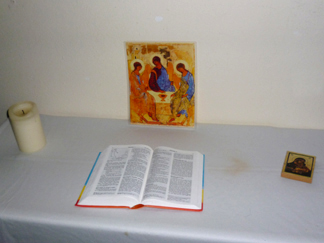 The event focussed on Jesus' experience of temptation in the wilderness. It also looked at how Lent is a time when Christians reflect on their spiritual life and how for some Christians this is a time of withdrawal from every day life. Lent is a time for choices: in this case to be empty or full, famous or trusting, powerful or serving. This event was offered to two classes at our local primary school and then after school as part of our Footsteps project. Introduction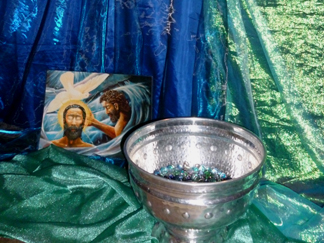
We would have liked to have begun with the children down by the font but, as our church is short of usable space, we needed that area for one of the stations. Instead we had a picture of Jesus's baptism and a silver "font" filled with water and blue shimmer stones. We asked the children what water made them think about and then began: "At the beginning of our world there was no water... and then there was water everywhere... Water reminds us of the dangerous waters of the flood – when Noah and the animals were saved on the Ark. We think about Moses leading the people out of slavery in Egypt through the waters to freedom." This was followed by the story of Jesus being baptised by John in the River Jordan: "Jesus answered something like: 'Baptise me for the journey. It needs to be like this for now. The path that God has asked me to walk begins with my baptism. Please baptise me.'" Before they moved on the children were invited to dip their fingers in the water and think about the importance of water. They were given cockle shell to remind them that they were going on a pilgrimage, a special journey. Station 1: The Desert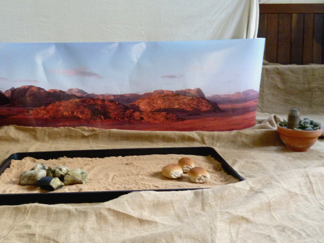 We took all the children together to watch a short film about the desert. "We have followed Jesus into the desert, into the wilderness... We often talk about the desert being a dangerous place but it can also be a place of calm and quiet... There is very little in the desert so it is a good place to think... Listen to the silence..." The children were then divided into three groups and sent off to visit the three stations to reflect on Jesus's temptations in the wilderness. Station 2: Bread and Stones: Empty or Full?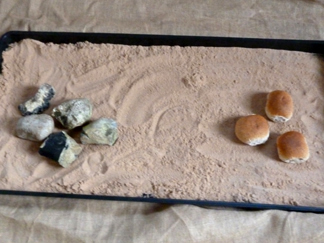 A large sand tray contained a pile of bread at one end and a pile of stones at the other. Behind stood a large poster of the desert, and hessian, cactus plants and bare twigs were used to create an impression of the bleakness and dryness of the desert. "Changing stones to bread would show how Jesus powerful was... Perhaps he would feel better if he had something to eat, if he was full up instead of empty. "But perhaps... perhaps he was meant to be empty... not for ever but just now, here in the desert. Perhaps if he changed the stones into bread he would become full – full not just with bread but with himself and his power. He would be filled with power but it wouldn't be God's power. 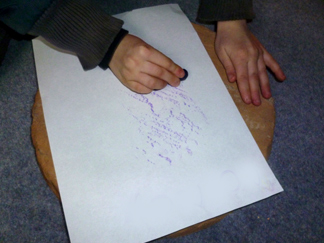 "It was a difficult choice... I wonder what you would choose?" (At this point the storyteller invited the children to respond.) "Jesus made up his mind, and perhaps he whispered to the desert, or perhaps he shouted: 'Human beings do not live on bread alone, but on every word that comes from the mouth of God!'" The children were sitting behind large round paving stones, two to a stone. They were invited to use the wax crayons and paper to make a rubbing of the stone, in silence, reflecting on what they had heard. Station 3: The pinnacle of the temple: Fame or Trust?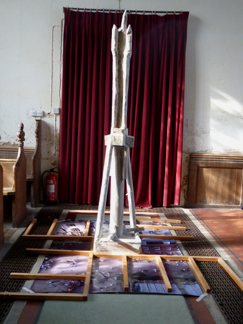 The pinnacle of the temple had been created out of cardboard for the original event held by the Cambridge Church Schools and we lucky to be able to borrow it. Underneath, also borrowed from the Cambridge Church Schools, was a large mat that had been created from a photo taken from the top of St Mary's Church tower in Cambridge. "Sometimes when you sit still and look and stare into the distance you can see pictures in your mind. You see might see places that you remember - places that you love and places that you hate. Places you would like to go back to and places you hope you will never see again. "When Jesus was alone, looking out over the desert, he saw the temple in Jerusalem, clear as anything. He saw the courtyards and the pillars, the altars and the priests, the smoke and the sacrifices. As he thought about the huge spaces and the tall pillars, he seemed to be lifted up higher and higher and higher, to the very top of the highest point of the temple..." 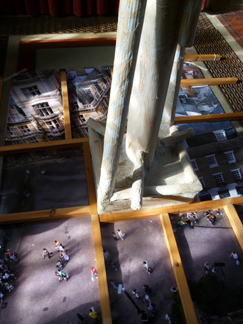 The children were asked to move and stand on one of the struts surrounding the pinnacle. Balancing on the strut and and looking down onto the tiny figures in the picture made the experience feel surprisingly real. "A thought came to Jesus out of the blue: "If you are the Son of God, throw yourself down!" "Should he do it?" "He would be famous. Everyone would want to meet the person who had thrown himself off the temple and been caught by angels! They would all want to follow him... They would listen to everything that he had to say. It would be easy. He wouldn't need God afterwards. He would be able to do everything himself. But wait – perhaps he was meant to need help from God? Perhaps he needed to keep trusting God? Jesus made up his mind and perhaps he whispered to the desert, or perhaps he shouted: "Do not put the Lord your God to the test!" 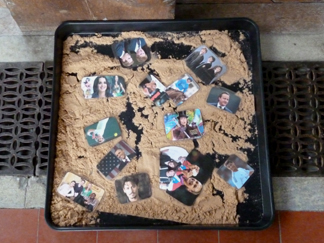 The children were asked to step down from the pinnacle and sit down. "I wonder what you think about being famous? Do you think it is a good thing or a bad thing?" "Would you like to be famous? Why?" "I wonder why Jesus chose not to be instantly famous?" They were then each given a white stone as a reminder that they themselves are unique and special. Pictures of famous people were spread out in a sand tray and the children were given the chance to sprinkle sand over them to symbolise that fame is momentary and rarely lasts. Station 4: The kingdoms of the world: Powerful or serving?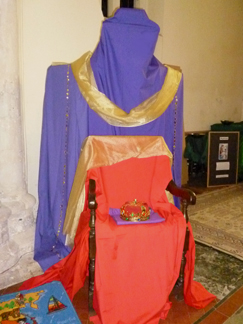 A mat showing a world map was spread on the floor, with small crowns placed on different countries. Symbols of kingship - throne, crown and jewels - were displayed nearby. We also had pictures of countries that Jesus himself would have known about - for example, Egyptian pyramids and ancient cities of Syria. "As he sat in the desert, Jesus began to think about being a king. "Suddenly a thought came to him, 'I can help you with this - I can give you all the kingdoms of the world in the palm of your hand - if you do things my way and worship me.' 'What is your way?' asked Jesus. Did it matter if he worshipped someone else? Surely he could still do God's work – or could he? Did it matter if he did something wrong, as long as the end result was good? I wonder what you think? Is it all right to do wrong things if the end result is good? Jesus made up his mind and perhaps he whispered to the desert, or perhaps he shouted: 'Worship the Lord your God and serve only God!' 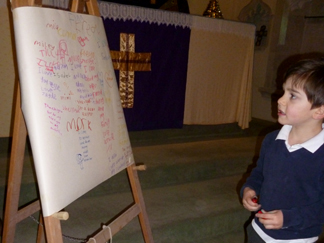 "People can be tempted to do something wrong so that they can be popular. Maybe they pick on someone and bully them, or look the other way when bullying is going on. People can make themselves feel powerful by picking on someone else, but it's a cheap kind of power and it won't last." We then showed the children a clip of Jessie J's anti-bullying song: "Who's laughing now?" The children were then given the choice to sign a board to show that they cared about other people and would refuse to do wrong to make themselves powerful. They could also choose to write a message on the board or write a private message which could be sealed in an envelope and later burnt. They were also given the opportunity to light a candle for someone. Poustinia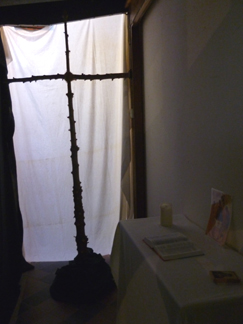 We gathered the groups of children back together and talked to them about the idea of Poustinia - small cabins, sheds or isolated huts, where Russian Christians go to pray and be alone with God. We had created our own Poustinia by using the narrow space behind the organ. We hung a white sheet at one end and placed our cross (made from our Christmas Tree) at one end. On a table was placed a candle, a Bible open at the story of the temptation in the wilderness and a couple of icons. The emphasis was on simplicity. While the children were having refreshments (drink and breadstick) they were given the opportunity to visit the "Poustinia." Creative Response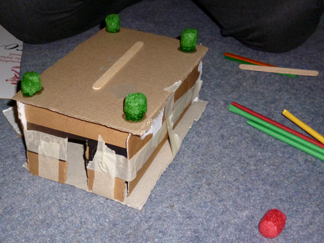 The children were invited to create their own "shed" or "Poustinia." We gave each child a cardboard base and then left them free to make their own designs. Materials available: cardboard; card; paper; coloured lolly sticks; art straws; sticky maize (we used coloured which dyed the carpet, plain would have been better); glue dots; masking tape (easier to use than sellotape) Sending out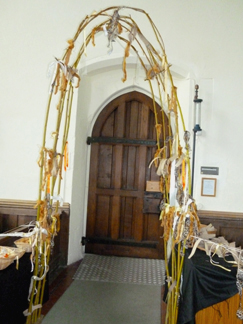 We had created a willow arch from thin branches of willow. 5 holes were drilled into two wooden bases and the willow branched were inserted. The tops were wired together to make an arch. To increase stability the arch was tied to the ends of the pews. We reminded the children of the choices Jesus had had to make in the desert: Shall I be empty or full? Shall I be famous or trustworthy? Shall I be powerful or shall I be a servant? "Jesus stayed in the desert for many days with the wild animals and the angels... Angels are messengers from God - they bring light, hope and comfort. They came to Jesus, but they didn't take him out of the desert and they didn't answer his questions for him. Jesus stayed in the desert for forty days. And when he had worked out some answers, enough answers, then it was time to go back to the towns and cities and begin the work of his life." 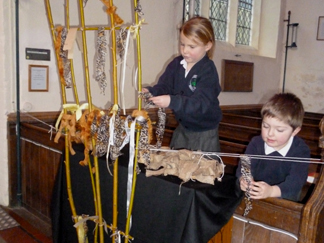 We asked the children to choose something to weave into the archway as a sign that they had been travelling together on this journey through the wilderness. The strips included: sand paper, hessian, string and dried plants (the desert); gold, yellow and flame coloured ribbons and white and yellow feathers (the angels); fur fabric, leopard fabric, white felt (the wild animals) How well did it work? This, the first of the Cambridge Church Schools exhibitions, had initiated a lot of thought and discussion as to how to achieve a "wow" factor for those who came. In this event it was undoubtedly the pinnacle of the temple. Balancing on the struts, while looking down on the tiny people far below, it was easy to feel as if you were at a great height, the wind blowing around you. Another discussion had centred on how to ground the event in the children's own experience. Children encounter the powerful in their daily lives, and so it seemed appropriate to include the focus on bullying (misuse of power) and the contemporary Jessie J video: "Who's laughing now?". The school sessions were attended by the Year 1/2 class (5 - 7 year olds) and the Year 4/5 class (8 - 10 year olds). 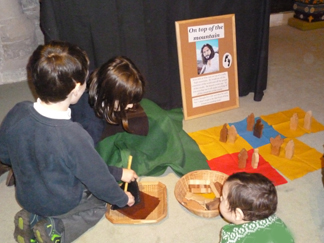 We found that all ages engaged with the stories, especially enjoying the chance to stand on the struts around the pinnacle. However the 5 - 7 year olds found the craft of making a "shed" quite difficult and needed help with using the materials and ideas as to what they could make. By contrast the 8 - 10 years olds had a wide variety of ideas and the skills to put their ideas into practice. Shed for Lent: the original event "Shed for Lent" was a play on words - thinking about the idea of a "shed" or "poustinia" as a place to go for prayer and reflection and also the idea of "shedding" or decluttering our lives during Lent. It was held in a modern city church where it was possible to move all the chairs to create a large open space that could be used as we chose and the wooden flooring helped create a warm atmosphere. This event was organised in a different way to subsequent events. After the welcome and introduction, two groups stayed to begin the craft while the third group worked in sequence round the four stations. When that group had moved to the second station, the second group was sent in to follow the same pattern. Finally the third group was sent in. 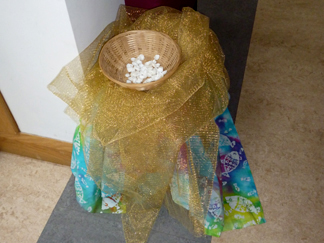 In subsequent events the children were split into three groups who rotated around the stations and the craft or other response was done together. The church had a beautiful stone font in the entrance to the church, and this was a key feature of the welcome, which focussed on the story of Jesus's baptism. Steps were placed so that the children could see into the font. Each child was given a cockle shell. Introduction: The desert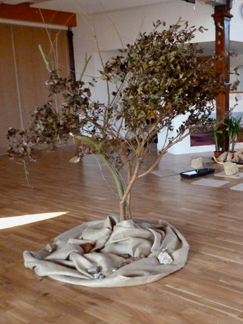 The children were taken into a large gazebo that had been erected in the large area between the entrance and the church and the church itself was hidden by closing the doors. Here the children were shown the film about the desert, with the noises of the wind and the sand. They were told about Poustinias, places to go to be alone with God, and shown pictures of Russian Poustinias. They were then divided into three groups: the first group were given the materials to create their own "sheds" while the second group had refreshments first before starting. The third group were taken through into the church. The stations had been created around the sides of the church, while a small tree in a pot was used as a central focus. 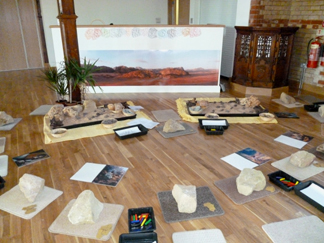 Station 1: Bread and StonesThe desert poster was used as well as two sand trays with bread and stones and a variety of cacti to give the impression of the desert landscape.A local garden centre generously allowed us to borrow some large stones, which the children used for rubbings. 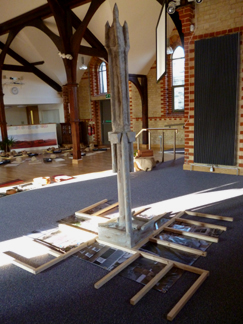 Station 2: The pinnacleThe pinnacle was set up at the entrance to the chancel. In contrast to our village church there was plenty of space around it and it served as a focus for the event. 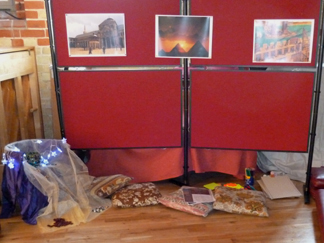 Station 3: Kingdoms of the worldThe pictures of ancient kingdoms were displayed on the board, while jewels and shimmer stones were laid out on a chair draped in shiny cloth. There was a small room nearby and the children were taken in there to watch the Jessie J clip, so that there was less disturbance to the rest of the event. 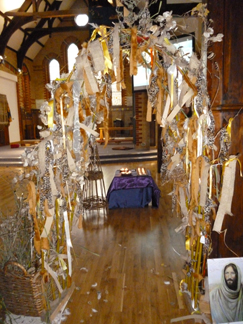 Station 4: Angels and wild animalsThis was the fourth and final station on the journey, where the children were given the opportunity to weave ribbons, plants and sandpaper etc into the willow arch. After this the groups were taken back to the craft, either to start making their "sheds" or to finish what they had begun earlier. On leaving the children were led through the arch and then between the lighted candles (from the Kingdoms of the World station) as a reminder of the journey we had been on together. Sarah(with thanks to Rowena Berridge, Ali Booth, Sheila Bailey, Sue Parr and the team and also to Rachel Nicholls, Victoria Goodman and the Cambridge Church Schools Trust events team) |